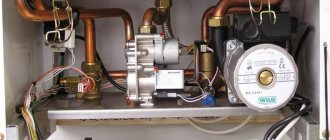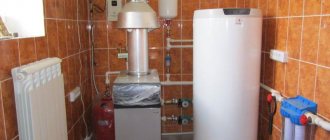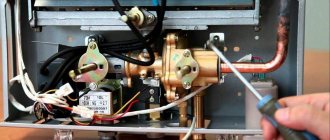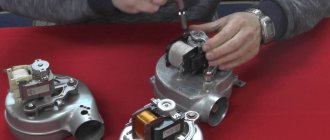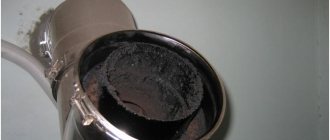Gas pressure at the entrance to the house has decreased
A gas boiler may not reach temperature due to low gas pressure. Typically, a sensor is installed at the entrance to the boiler to measure pressure. First of all, its indicators are checked to make sure of this malfunction.
Also read with this article: What to do if the pressure in the gas boiler increases
Modern heating equipment is often equipped with a pressure reducer. Adjusting the values on it helps solve the problem described. For private houses with one or two floors, the optimal value is from 1.5 to 2 atmospheres. In houses with more than two floors, the gas pressure should be in the range from 2 to 4 atmospheres.
ATTENTION. Any boiler adjustment requires a careful approach with preliminary study of the instructions. Gas is a dangerous flammable component that can lead to explosions and fires if consumed incorrectly. If you doubt your own abilities, contact a company that services gas installations.
The insertion was carried out poorly: the diameter does not match or there are narrowings in the gas pipeline
A common reason for a complaint that a gas boiler in a house does not heat well is poor-quality connection of heating equipment to the general gas supply system (gas pipeline).
Often, gas service workers weld an additional thread, screw a tap onto it and drill a small hole where the thread joins the gas pipe. The diameter of such a hole is much smaller than the diameter of the pipe, which leads to a drop in pressure. As a result, the gas boiler does not heat hot water well.
Correct connection requires compliance with certain rules and takes more time. Therefore, negligence occurs frequently.
You can determine this reason in the following way:
- there is a sharp decrease in the flame after ignition of the boiler;
- stops gaining temperature, or the flame goes out on its own.
Special calculators are used to calculate the required diameter of pipes in a particular room. The power of the boiler requires a larger volume of gas supply, therefore it is necessary to use pipes with a larger diameter. Before connecting the boiler to the gas pipeline, you must call a qualified specialist who will calculate the required diameter for the pipes, taking into account the characteristics of the room and the power of the boiler.
The following factors influence the choice of a larger cross-section in the connected pipes:
- low pressure requires connection to pipes with a large diameter;
- boiler power and room area affect the diameter;
- the longer the system, the larger the cross-section must be used;
- a reserve in diameter is necessary when there are many turns in the system (gas flow slows down at turns);
- number of consumed points;
- the required room heating temperature with the water heating temperature for domestic use;
- what pump is installed in the boiler.
Siberia model range
Household heating equipment produced under the Siberia brand has a wide range of models. Today the company offers its consumers the following boilers:
- Floor standing boilers with steel heat exchanger. Reliable dual-circuit device with an atmospheric burner.
- Single-circuit units with a cast iron heat exchanger of increased power. Ideal for heating a large country house. Some models can be equipped with an indirect heating boiler.
- Wall-mounted models are compact and high-performance.
Let's look at the technical characteristics and design features of Siberia boilers in more detail.
Floor equipment
Siberia floor-standing boilers are available in two types:
- With steel heat exchanger.
- With cast iron heat exchanger.
Models with a steel heat exchanger have an additional copper circuit for connection to the hot water supply system. The automatic control unit (SIT) includes:
- magnetic valve;
- modulation thermostat;
- pressure stabilizer and gas filter;
- thermoelectric device with piezo ignition and flame control sensor.
The advantageous characteristics and design features of these Siberia units are the following:
- Optimal dimensions and modern design.
- Ease of automation control.
- Wide range of powers from 11 to 35 kW.
- High efficiency – 90%.
For uninterrupted heating of a private home, the Siberia single-circuit boiler with a cast iron heat exchanger is ideal. If there is a heating system with natural circulation, this gas appliance is able to provide heat even when the electricity is turned off.
Increased reliability, simplicity of design and control make such boilers the best option for the Russian outback, where there are problems with electricity and pressure in the gas main. Here are some technical characteristics and advantageous features of units in this series:
- Increased power (from 16 to 50 kW) is suitable for heating areas up to 500 m2.
- The modern stylish design allows the massive device to look organically in any room.
- Quiet operation.
- High efficiency.
- Durability of the heat exchanger, as well as other parts and components of the boiler S
Wall-mounted devices
The Siberia wall-mounted double-circuit boiler is in high demand among consumers due to its functionality, practicality and reliability. Thanks to its compact dimensions, closed combustion chamber and coaxial chimney, installation of this heating device is possible even in small rooms.
Let's look at the main technical characteristics and advantages of Siberia wall-mounted boilers:
- Copper bithermic heat exchanger Gianoni.
- Polidoro gas burner made of alloy steel.
- Automation based on a Honeywell electronic board produces smooth modulation of the flame on the burner, which allows for rational consumption of energy.
- This boiler is equipped with a modern anti-freeze function for the heating system.
- Liquid crystal display, which displays current information about the state of the unit and error codes in the event of a malfunction or malfunction of the system.
As you can see, the Rostovgazoapparat company produces modern, reliable Siberia gas appliances, suitable for heating small apartments and country cottages. A dual-circuit unit will allow you not to worry about the availability of hot water for domestic needs. The high quality, simplicity and reliability of equipment from this brand are deservedly appreciated by consumers.
Discrepancy between the volume of water consumed and the power of the boiler used
If residents complain that there is no hot water coming from a gas boiler in a private house, the reason may be the fact that significantly more hot water is consumed than the boiler can physically heat. Heating hot water in a boiler is not an instantaneous operation. Therefore, the volume in the coolant must fully correspond to the amount of consumption.
The room is heated by water flowing in pipes (batteries). While it makes a full circle, it cools down. Therefore, during this time, a single-circuit or double-circuit gas boiler in a private house must heat the water for the next circle so that the circulation of the warm flow is continuous.
Too much draft in the chimney
High-quality supply ventilation in high chimneys leads to strong draft. Too much draft blows the flame away with strong gusts of wind, like outside.
Read more in the article: Why does the wind blow out a gas boiler?
Consequently, a gas boiler does not heat running water in the system well. To understand this reason, you need to imagine a burning fire in the middle of a field with a strong wind (the flame will also be blown out by the wind).
The normal indicator is changing the air in the boiler room three times. Sometimes, the indicator reaches ten or fifteen times during the period of heating the water for the next circle. Modern heating systems are equipped with special systems (dampers) that regulate draft. However, many older models remain sensitive to the force of the air flowing outside.
Problems with setting the boiler gas valve
It is necessary not only to install the device correctly, but also to set up hot water on the gas boiler. If this is not done, the outlet pressure may be lower or higher than the specified norm, as well as a number of other errors made by unqualified specialists.
In this case, the device will operate at only part of its capacity. Consequently, heating in a room with a heating boiler will be less efficient. If this reason is identified, it is necessary to call specialists from the service company to eliminate the error.
We recommend reading with this article: How to properly configure a heating boiler
Operating rules
In order for a solid fuel boiler to operate safely and efficiently, you should follow some simple rules when operating it:
- Install only on fireproof materials. A metal sheet with a thickness of 0.6-1 mm with a backing of asbestos or basalt cardboard with a thickness of at least 3 mm should be laid under the base of the device. Moreover, the metal sheet should be located not only under the device itself, but also protrude from the front side by 0.5 m.
- Do not use flammable liquids for kindling.
- Before ignition, ventilate the firebox for 10-15 minutes.
- Keep the firebox doors tightly closed during operation.
- Do not leave unattended for a long time.
- Carry out periodic cleaning of chimneys.
- At the end of the heating season, lubricate the moving parts of the device mechanisms with graphite lubricant.
Gas filter clogged
It is installed at the inlet of the boiler to further filter the incoming gas. Protects heating equipment from substances that cause malfunctions. A clogged gas filter delays the flow of gas, which reduces the combustion force, and accordingly the temperature in the house will drop.
The degree of contamination is assessed visually when the filter is unscrewed from the boiler. It is necessary to perform such a manipulation when the equipment is completely turned off.
Attention: A dirty filter must be replaced with a new one.
The occurrence of leaks in systems with automatic make-up
Automatic make-up systems are installed in powerful boiler houses serving industries and apartment buildings. In large private houses, sometimes they resort to a similar measure to strengthen the heating system.
The operating principle of automatic recharge is as follows. When the pressure of the incoming gas drops, the system turns on and maintains the required level for some time. The system is equipped with a pressure sensor, which it completely relies on for operation. For example, a water leak in pipes led to a drop in pressure. The make-up system pumps in a larger volume of new water to maintain pressure.
For some time, the system will retain heat. However, a large supply of new water will lead to the fact that the device will not have time to heat it and, accordingly, the boiler itself will not maintain the set temperature of hot water in the system.
What to do if the boiler cannot reach temperature?
The above recommendations are relevant when deliberately reducing the operating parameters of the boiler in order to achieve a cooler microclimate during the heating season. But what to do if the boiler does not heat up enough and the room is too cold?
If the unit is not able to reach the set temperature, the following reasons are possible:
- too weak draft in the chimney;
- the grate became clogged with ash;
- The heating system was originally designed incorrectly.
When cleaning the device and chimney does not produce results, the only effective way to improve functionality is to contact specialists.
The heating system works as a closed circuit, the links here are the heating boiler, pipelines, radiators, pumps, and fittings. It is important that the specifics of the relationship between these components be taken into account at the design and assembly stages of the network. The key mistake of boiler owners is considered to be underestimating the supply temperature; this problem is also typical for the return.
If the boiler operates in tandem with a draft regulator (the latter provides combustion automation), owners often set the temperature on the regulator to below 65°C. Such “amateur activities” are relevant for the off-season, when you want to lower the temperature in the room, because it is warm outside, and also if the number of radiators was initially selected incorrectly or the incorrect total volume of coolant is used.
If the working fluid present in the system exceeds the technological needs of the boiler, the temperature of the circulating coolant may drop below 60 ° C, in this case the heat exchange surfaces of the equipment are abundantly covered with condensate, soot settles more strongly, as a result, the performance of the boiler decreases. In situations where a nominal coolant temperature of 60°C is objectively required, it is necessary to introduce a recirculation pump or mixing valve into the system.
The source of problems can be a suppressed operating mode of the boiler - this is how the lack of oxygen in the combustion chamber manifests itself. As a result, the fuel does not burn completely and unevenly, the draft deteriorates due to the greasing of the internal surfaces of the channels, and the formation of semi-coke gas makes itself felt.
A solid fuel boiler is a heating device made of plate steel or cast iron. The release of thermal energy in installations occurs due to the combustion of solid fuels (coal, firewood, peat, coke, pellets). Boilers of this type are used in private households and industrial facilities where there is no gas pipeline. They are also installed as backup heating equipment.
Heat exchanger clogged
Despite the fact that in every gas heating system, water purification filters are installed at the coolant inlet, the heat exchangers tend to become dirty. The cause of pollution is due to various natural impurities found in water. Salt and calcium deposits form on the walls, which are not so easy to clean. And if this is not done on time, then over time the heat exchanger will fail.
The shelf life also depends on the material. For example, the most durable ones are cast iron, although they are the most expensive. The most unreliable are steel ones. Their service life is only about 3 – 5 years.
You can read more about heat exchangers here: Which heat exchanger design and material to choose
You can find many cleaning methods on the Internet. Let's look at the two most popular ones.
Chemical cleaning of biothermal heat exchanger
Modern technologies use special chemical reagents to clean the bithermal heat exchanger. Before performing any manipulations, the boiler completely stops and cools down. Then the heat exchanger is removed. There may be water left in it, so it must be carefully drained.
In a container of sufficient size to completely immerse the heat exchanger, liquid with chemical reagents is diluted, then the bithermic heat exchanger is immersed. Cleaning time, solution concentration, and the need to use additional protective equipment (gloves) are indicated in the instructions for use for each individual reagent and depend on its chemical properties.
After this procedure, the hot water (heating) heat exchanger is washed under cold running water, dried, and installed in place. You can run it.
Chemical cleaning of the secondary heat exchanger
To chemically clean the secondary heat exchanger, you can use citric acid, active thermal agent, STEELTEXT Cooper, Detex liquid concentrate or hydrochloric acid. The choice of one or another component depends on the degree of contamination and the material from which the heat exchanger is made. It is necessary to pump 10 liters of solution to clean it thoroughly.
The process of removal and installation with cleaning is best left to professionals. Gas equipment is complex, despite its apparent simplicity, and dangerous for unqualified maintenance.
What layer thickness should there be for a single loading of coal into the boiler?
Before throwing coal, be sure to close the ash pit. The first layer of coal is laid with a thickness of 5-6 cm. After it burns out, a second layer with a thickness of about 15-20 cm is laid. Further layings also have this thickness.
Interesting materials:
How to erase putty in a diary? How to wash a linen suit? How to wash clothes with prints? How to wash a Cheburashka fur coat? How to wash hand-painted items? How to Stream from PS5? How to dry watermelon rinds in the dryer? How to dry arugula for the winter? How to dry carrot seeds? How to dry dried flowers in semolina?
Problems with the flow sensor
Heating equipment is equipped with various sensors. Among them are water temperature sensors, combustion sensors, flow sensors and others. A failed flow sensor leads to automatic shutdown of the boiler with a corresponding error message.
To determine the error by the displayed code, you need to look at the instruction manual. The identified cause is corrected by replacing the faulty sensor with a new one. To do this, it is recommended to call a service company.
We recommend reading: Why the gas boiler does not work, causes and troubleshooting methods.
Problems with closed-type turbocharged equipment
Sometimes when installing a new chimneyless apparatus, the flame periodically goes out. In this case, you need to check the components and parts. The problem is detected by the following factors:
ignition of the igniter is accompanied by periodic attenuation - this indicates a failure of the thermocouple, which affects the operation of the valve. It is produced in the form of a copper tube with a bimetallic piece at the end. When different metals come into contact, the voltage increases to 20-45 W. This problem keeps the gas valve open. The thermocouple must be replaced with a new one; it cannot be repaired;
- breakdown or clogging of the traction sensor - the flat part is combined with the fuel valve. When the leading contacts are closed and the burner is ignited, a fire occurs - this indicates the need to replace the sensor. Oxidized areas of contacts can be cleaned with sandpaper with fine abrasives;
- if the circulation pump malfunctions, it is necessary to carry out a complete diagnosis of the unit and replace it;
- A yellow flame is due to the fact that the jet is clogged. You can clean it if you have experience working with gas appliances.
Most of the reasons can be eliminated with your own hands, however, this will require some knowledge and a lot of time.
The hot water temperature sensor is faulty
The second most important sensor measures the temperature in the water supply system in the house. This malfunction can cause the faucet in the house to supply water that is too hot or not hot enough.
When turning on the water on the faucet, a person does not think about possible malfunctions and can easily get burned. Therefore, this malfunction leads to the boiler stopping with the corresponding error being displayed. Some manufacturers do not equip boilers with a stop system in case of this malfunction, so consult with specialists which equipment to choose before purchasing.
Excess power
Excess power, as well as its lack, negatively affects the heating device. It can also lead to overheating and other problems. Therefore, the device stops in emergency mode and displays the corresponding error. You can try restarting the heating equipment. However, first, it is better to understand the reasons and eliminate them.
In conclusion, it should be noted that some faults can be determined independently by the method of elimination. Errors shown by the boiler are always described in its documentation. But it is not recommended for people without certain qualifications to interfere with the operation of the device.
Why does the heating boiler constantly turn off?
Similar problems occur both in new, newly installed units, and in those that have served for several years.
The reason is external and internal factors. Users often complain that the boiler turns off and does not turn on after a long period of inactivity. For example, at the dacha you start the device only upon arrival, which can cause the system to freeze. The main causes of the problem lie in:
- Incorrect power selection.
- Heating or hot water supply system (DHW).
- Smoke removal unit.
- Gas main.
- Electrical part.
- Incorrect adjustment.
Both wall-mounted and floor-standing boilers are susceptible to problems. What to do to eliminate them? Find the cause and try to eliminate it.

